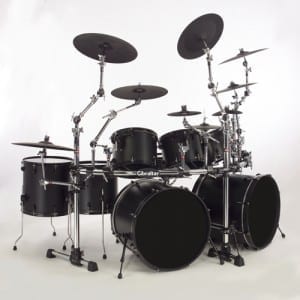 If you’re already a solid drummer using a single bass drum kit, double bass can be a great way to add more punch to your sound, and it’s not just for the metal guys. The big, booming sounds of double bass drums are sonic staples in the world of heavy metal and punk, but did you know the technique actually originated in the jazz music of the 1940s and 50s? As you learn more about how to play double bass drums, you’ll find the technique and its history have a lot to offer beyond just hard rock.
If you’re already a solid drummer using a single bass drum kit, double bass can be a great way to add more punch to your sound, and it’s not just for the metal guys. The big, booming sounds of double bass drums are sonic staples in the world of heavy metal and punk, but did you know the technique actually originated in the jazz music of the 1940s and 50s? As you learn more about how to play double bass drums, you’ll find the technique and its history have a lot to offer beyond just hard rock.
Getting Started
In order to play double bass drums, you will need either a kit with two bass drums and two pedals, or a special double bass pedal. If you’re practicing in a small space or on a tight budget, a double bass pedal is probably a better choice for you. If you’re ready to commit to expanding your kit, or you just want to play super loud, go ahead and get a second bass drum.
Warming Up
When you play double bass drums, you’ll need to be able to alternate beats between your right and left foot very rapidly. If you’re not used to this motion in your calves, it’s a great idea to stretch and warm up before you play so you don’t pull a muscle. Before you start out at your kit, practice some calf raises to warm up your muscles and build the strength and endurance you’ll need to play double bass drums.
Check Your Gear
How is the tension in your pedal? If it’s wound too tight, you’ll need to push harder which can cause you a lot of strain and frustration. You can loosen or tighten your pedal’s spring tension to get the level of responsiveness that is comfortable for you. When you’re playing double bass drums, it’s a good idea to get both pedals set up about as evenly as possible. This helps you play evenly and develop equal strength in both legs.
Start Slow
Practice playing just your bass drum pedals, alternating left and right in time with a metronome. As you feel comfortable, increase the speed of the metronome and add more complex variations (i.e. left-right-left-left or right-left-right-right instead of just alternating left and right). Be patient with yourself and keep practicing! Over time, you will develop more speed and power in your drumming.
Heel Up or Heel Down?
Bass drum pedals can be played with your heels up or down. Both techniques are valid, though heel up tends to be better for players who would like to produce greater speed and power. As you’re playing the drums, experiment with each technique and notice which feels better in your body. If you’re not sure which technique is best for you, a private drum teacher can help you identify what you need to do.
Set Records
Many double bass drummers feel a need for speed! If you’re trying to improve your speed, stick with your drum practice and keep a practice journal to chart your progress. You might find that you have a dominant foot and a weak foot. Pay extra attention to strengthening your weak foot as you practice and you will see big improvements. Additionally, focusing on endurance as well as speed will help you step up your drum game. After all, when you’re playing drums with a band, you’ll need to be able to keep up your speed for entire songs at a time.
Although it seems counter intuitive, another way to build your speed is to relax the tension in your legs and feet. Relaxing your muscles allows you to move much more quickly. Making smaller movements will also help you to go faster. Instead of stomping on your pedals, imagine that your feet are vibrating the pedals like the wings of a hummingbird.
Curious just how fast a double bass drummer can really go? Drummers are constantly finding ways to get faster and smash previous world records for the fastest double bass drummer. Just a quick search on YouTube will show you examples of drummers playing as fast as 1530 strokes a minute. Spend time watching some super fast drummers and see if you can pick up on their techniques!
Studying your instrument with the guidance of a professional instructor is the best way to make progress and learn deeply. TakeLessons offers private music instruction, with teachers available for in-person or online lessons. Our teachers create individual lesson plans, so your experience is tailored to what YOU want to learn! Find out more about private lessons and find your perfect teacher today!
You might also like…
–Heavy Metal Drumming
–5 Impressive YouTube Drummers
–Video: 3 Bass Pedal Techniques
Photo by Gibraltar Hardware
Megan L.
